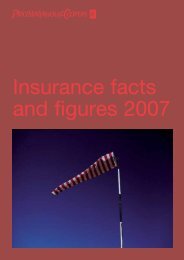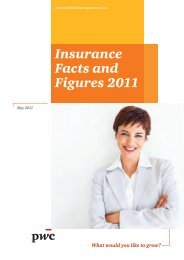Dataline A look at current financial reporting issues - PwC
Dataline A look at current financial reporting issues - PwC
Dataline A look at current financial reporting issues - PwC
Create successful ePaper yourself
Turn your PDF publications into a flip-book with our unique Google optimized e-Paper software.
Topic Initial ED Revised ED <strong>PwC</strong> observ<strong>at</strong>ions<br />
Disclosure<br />
Lessees and lessors<br />
should disclose<br />
qualit<strong>at</strong>ive and<br />
quantit<strong>at</strong>ive<br />
inform<strong>at</strong>ion th<strong>at</strong> (a)<br />
identifies and<br />
explains the amounts<br />
recognized in the<br />
<strong>financial</strong> st<strong>at</strong>ements<br />
arising from leases;<br />
and (b) describes<br />
how leases may affect<br />
the amount, timing<br />
and uncertainty of<br />
the entity’s future<br />
cash flows.<br />
Lessee's should disclose a<br />
reconcili<strong>at</strong>ion of the opening<br />
and closing balance of lease<br />
liabilities for both I&A and SLE<br />
leases, a single m<strong>at</strong>urity analysis<br />
of the undiscounted cash flows<br />
rel<strong>at</strong>ed to all lease liabilities,<br />
and costs for the period rel<strong>at</strong>ing<br />
to variable lease payments not<br />
included in the lease liability.<br />
Lessors should disclose a table<br />
of all lease-rel<strong>at</strong>ed income<br />
items, a reconcili<strong>at</strong>ion of the<br />
opening and closing balance of<br />
the right to receive lease<br />
payments and residual assets,<br />
and a m<strong>at</strong>urity analysis of the<br />
undiscounted cash flows th<strong>at</strong><br />
are included in the right to<br />
receive lease payments.<br />
Although changes have been made to the disclosures to be required in the<br />
revised ED, constituents are likely to make similar comments to those raised on<br />
the initial ED.<br />
Companies are likely to consider the proposals overly burdensome, specifically<br />
the requirements to provide a number of reconcili<strong>at</strong>ions of balance sheet,<br />
income st<strong>at</strong>ement, and cash flow st<strong>at</strong>ement activity.<br />
Financial st<strong>at</strong>ement users may raise concerns about the piecemeal n<strong>at</strong>ure of the<br />
disclosures, questioning how intuitive it will be for users to put together the<br />
various pieces of disclosure to provide them with useful inform<strong>at</strong>ion about an<br />
entity's lease activities. These concerns were raised by some of the FASB<br />
members who are contempl<strong>at</strong>ing providing an altern<strong>at</strong>ive view in the revised<br />
ED.<br />
Finally, some may question how the disclosure proposals align with the FASB's<br />
thoughts in its recently issued discussion paper entitled the Disclosure<br />
Framework.<br />
Note: Listing is not inclusive of<br />
all required disclosures.<br />
Discount r<strong>at</strong>e<br />
A lessee should use<br />
the incremental<br />
borrowing r<strong>at</strong>e or, if<br />
it can be readily<br />
determined, the r<strong>at</strong>e<br />
the lessor charges the<br />
lessee.<br />
A lessor should use<br />
the r<strong>at</strong>e the lessor<br />
charges the lessee<br />
Lessees should discount lease<br />
payments using the r<strong>at</strong>e charged<br />
by the lessor if known;<br />
otherwise, the lessee’s<br />
incremental borrowing r<strong>at</strong>e<br />
should be used.<br />
Lessors should discount lease<br />
payments using the r<strong>at</strong>e they<br />
charge in the lease.<br />
The discount r<strong>at</strong>e should not be<br />
reassessed if there is no change<br />
in lease payments.<br />
Lessees would not be oblig<strong>at</strong>ed to seek out the r<strong>at</strong>e the lessor is charging in the<br />
lease. The r<strong>at</strong>e the lessor is charging is more likely to be identifiable in<br />
equipment leases, particularly when the equipment may also be purchased<br />
outright. For other types of leases, including real est<strong>at</strong>e leases with rents based<br />
on cost per square foot, the lessee rarely knows the r<strong>at</strong>e the lessor is charging<br />
because it is typically not relevant to negoti<strong>at</strong>ions.<br />
In determining the incremental borrowing r<strong>at</strong>e, the lessee uses a discount r<strong>at</strong>e<br />
commensur<strong>at</strong>e with a secured borrowing th<strong>at</strong> the lessee could obtain to finance<br />
the purchase of the specific asset over a borrowing term consistent with the<br />
initial expected term of the lease (including any extension options th<strong>at</strong> include a<br />
significant economic incentive to exercise). For example, if a company were<br />
entering into a lease of a property in Chicago with an assumed term of 10 years,<br />
it would use a r<strong>at</strong>e consistent with a 10 year fixed r<strong>at</strong>e secured borrowing for<br />
N<strong>at</strong>ional Professional Services Group | CFOdirect Network – www.cfodirect.pwc.com <strong>D<strong>at</strong>aline</strong> 27

















